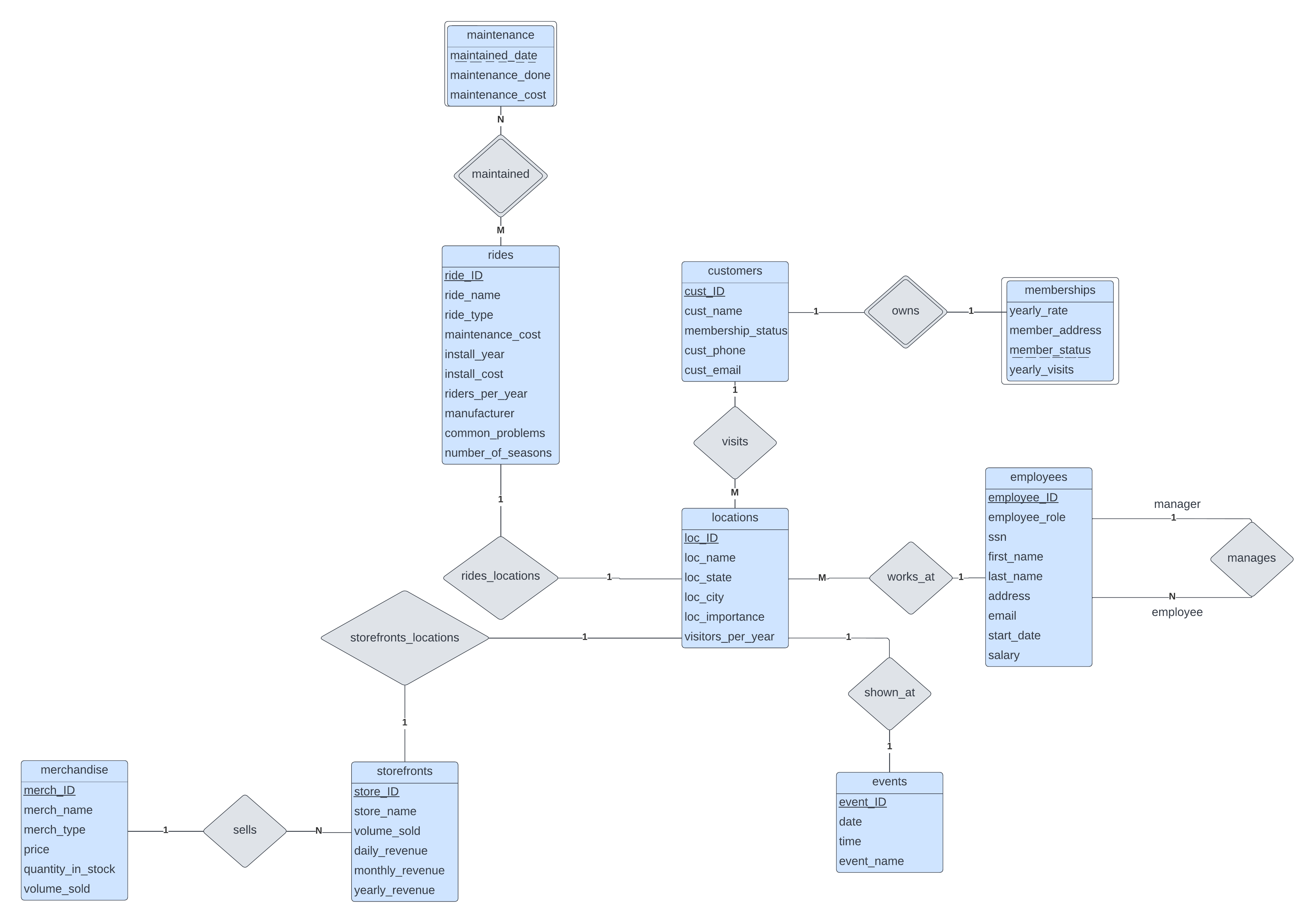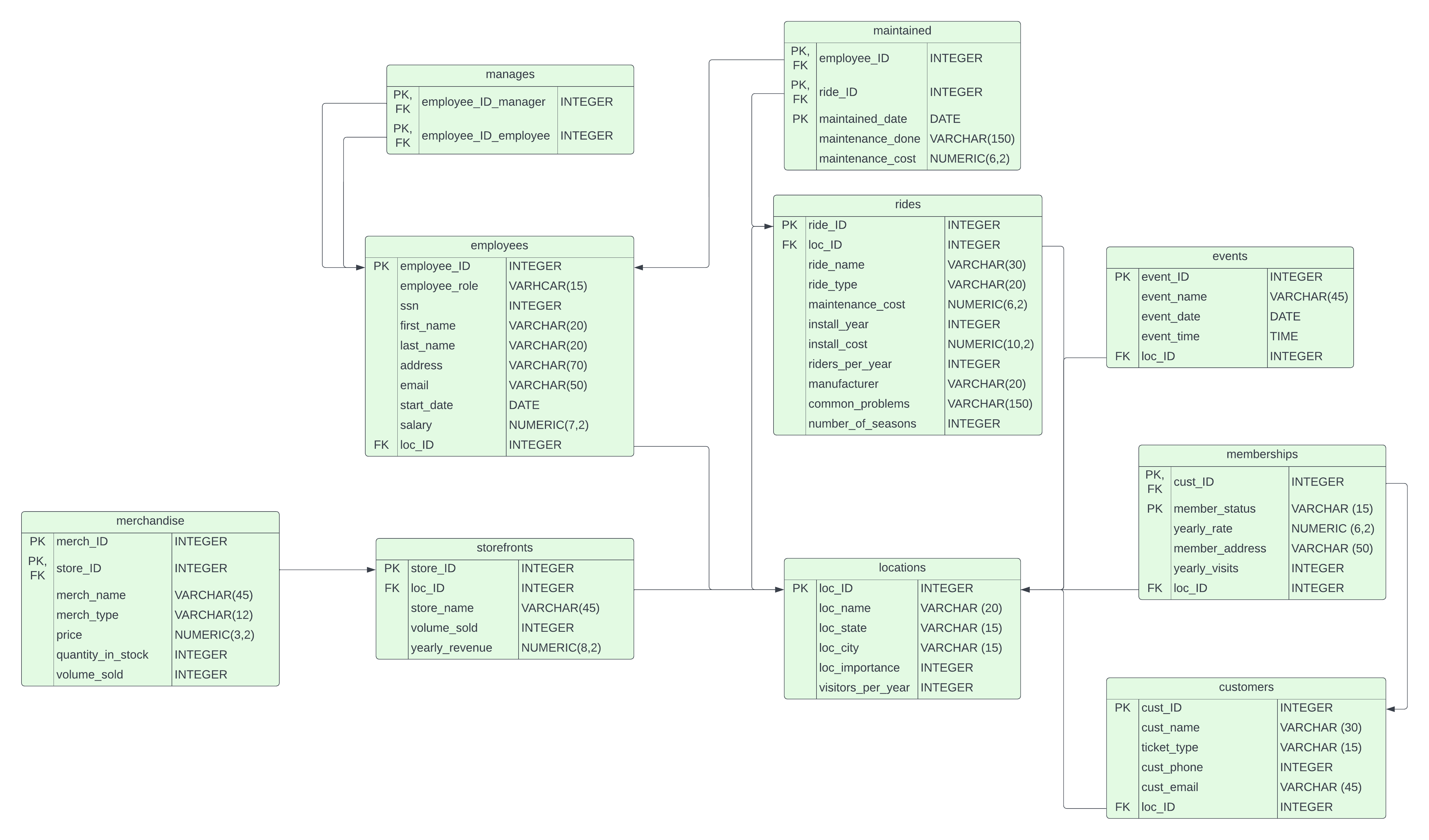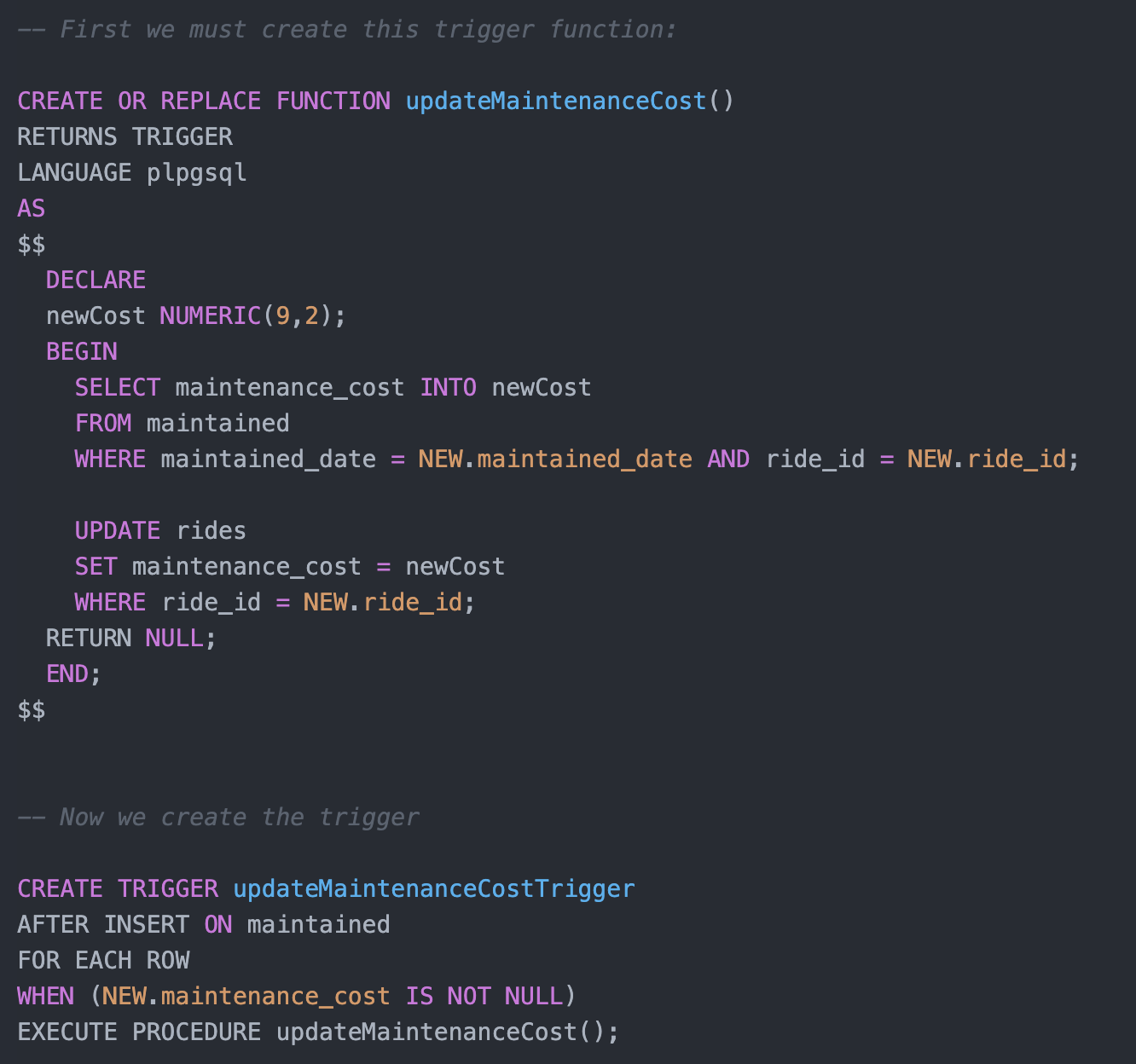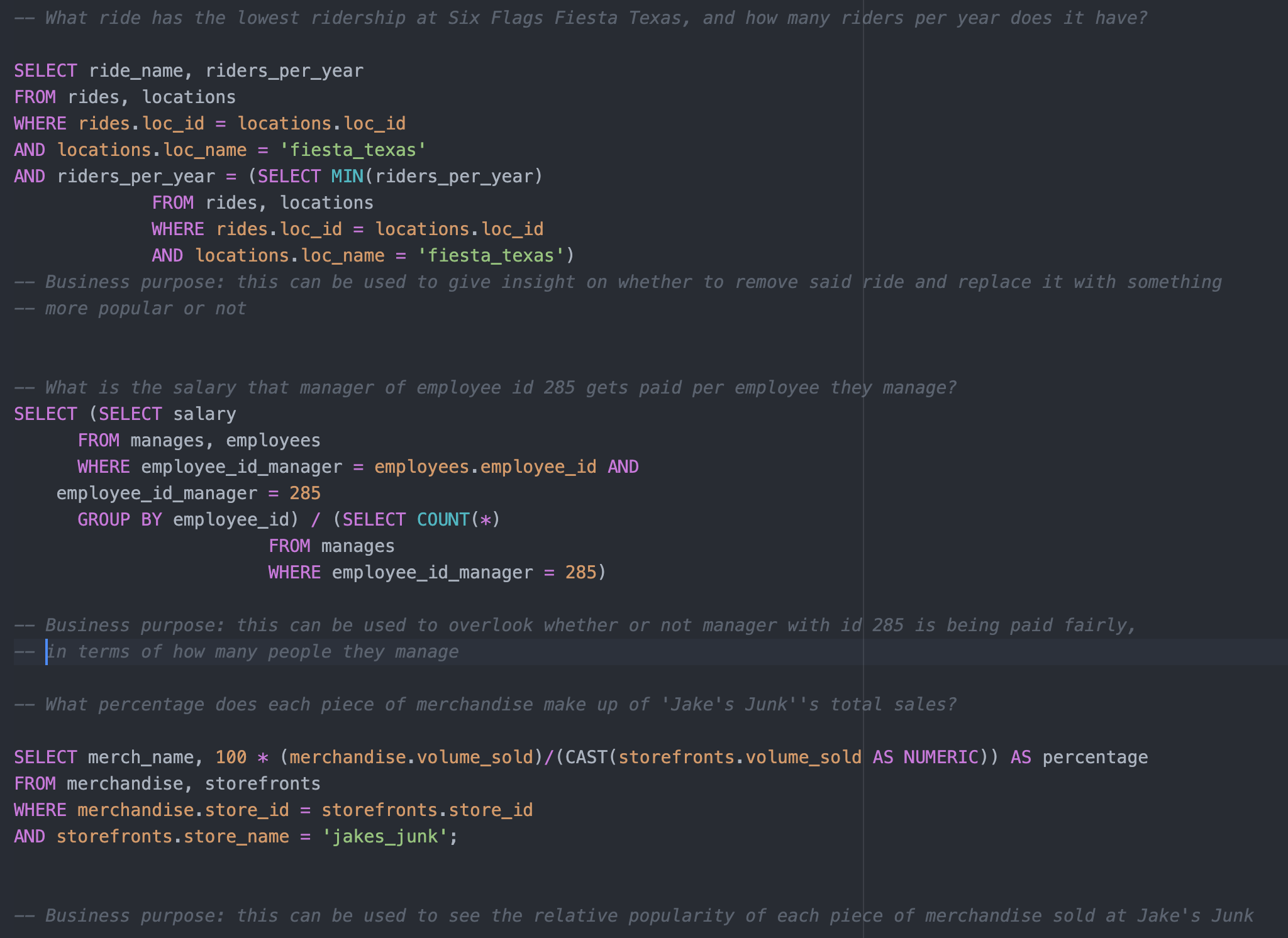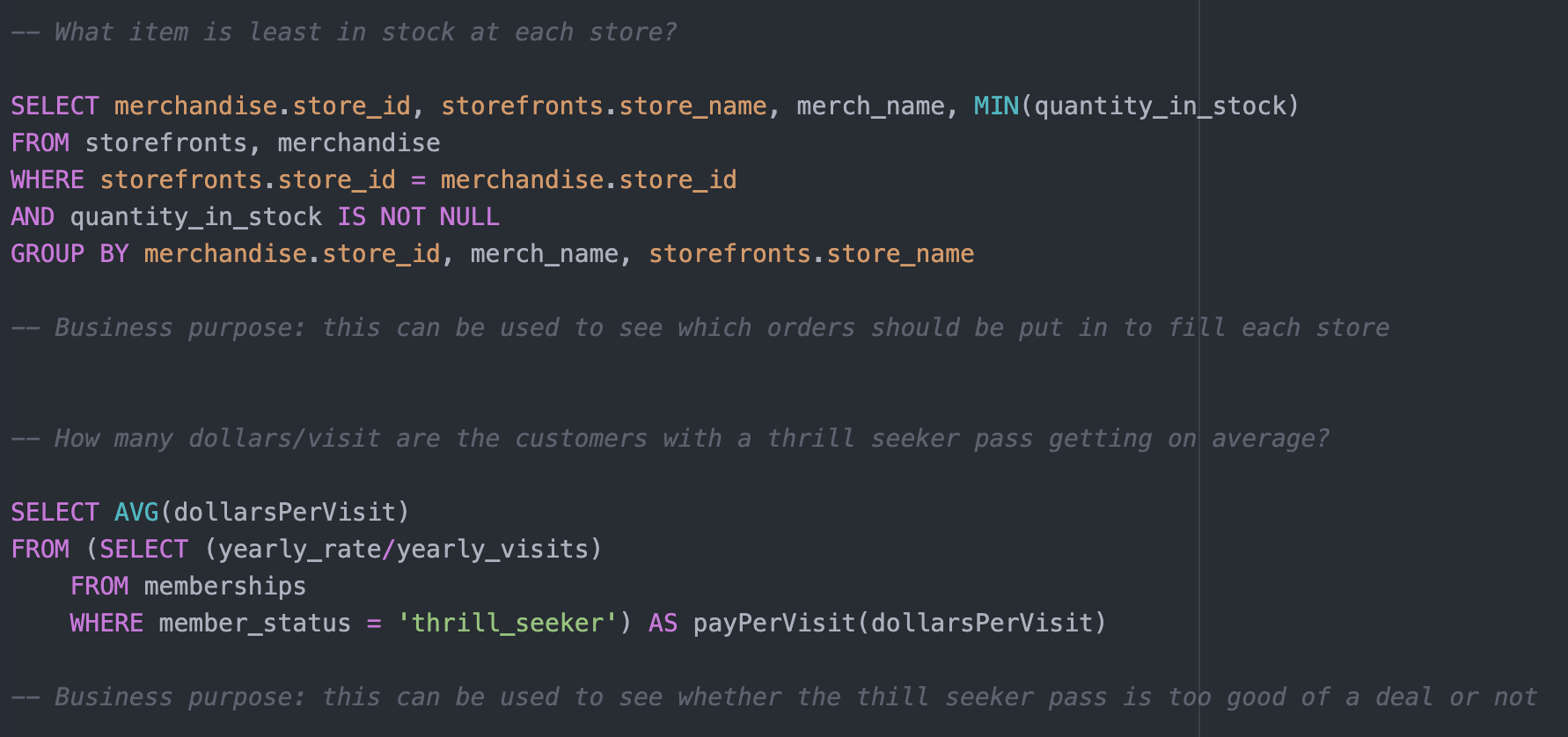I’ve always been quite interested in theme parks and rollercoasters. Ever since I was a kid I’ve been playing the Rollercoaster Tycoon games, a series of games focused on theme park management. I decided to take on the challenge of managing a chain of theme parks from a database perspective. I decided to create a database for the Six Flags chain of amusement parks. While there are four other major park chains in the United States (Cedar Fair, Disney, Universal, and SeaWorld), Six Flags is the chain I have the most experience with.
Data and Functional Requirements
Amusement parks are an ever-changing industry. Various attractions are torn down at a moments notice, customers and employees come and go, and parks that are part of a chain are added and removed constantly. Because of this, most of the data in this database must be available to be continuously updated, inserted, and deleted. The exceptions to this rule are the customers table, where data is only inserted once and never deleted, and the maintained table as data is also only inserted once and never deleted.
The most central entity set in this database is the ‘locations’ entity set. This set has an attribute which assigns each location a unique identifier (loc_ID), the name of the location (loc_name), the state the location is in (loc_state), the city the location is in (loc_city), how important the park is in the chain (loc_importance), and the amount of visitors per year that the park gets (visitors_per_year). The purpose of the ‘loc_importance’ attribute is to distinguish between how the corporation, Six Flags, views each one of their 13 amusement parks in the US. Six Flags does not in any way invest equally into each of their parks: there are very clear winners and losers. A park with an importance rating that is a low number indicates that the chain is willing to invest significantly more money into the park than a park with a high importance rating number.
The ‘customers’ entity set lists information about each customer that attends a park, both customers with memberships and single-day customers. As for the attributes, ‘cust_ID’ is the unique identifier for each customer, ‘cust_name’ is the customers name, ‘membership_status’ details whether the customer had a single-day pass or some type of membership, ‘cust_phone’ is the customer’s phone number, and ‘cust_email’ is the customer’s email address. These are all pieces of information one has to give Six Flags in order to visit one of their parks, so I thought it relevant to include these attributes. The ‘customers’ table includes the foreign key ‘loc_ID’ as customers are specific to each park. The ‘customers’ entity set is connected to the ‘locations’ entity set through the ‘visits’ relationship set, through a one-to-many relationship. Each customer can visit many Six Flags parks, but each park can only have one of each customer.
Certain customers may own a season pass or a membership, and for that reason the ‘memberships’ entity set exists. The attributes of the ‘memberships’ entity set are: ‘yearly_rate’ (the amount that has to be paid yearly by the members), ‘member_address’ (the address of the member), ‘member_status’ (the specific name of the membership the member pays for), and ‘yearly_visits’ (the amount of times the member has visited the park within the past season). The ‘memberships’ table has two foreign key constraints: ‘loc_ID’ as each member initializes their membership at a specific park, and ‘cust_ID’ as each member is also a customer. This is a weak entity set as there are no unique primary keys, however a partial key is the ‘member_status’ in conjunction with the foreign key ‘cust_ID’. This ‘memberships’ entity set is connected to the ‘customers’ entity set through a relationship set called ‘owns’. This is a one-to-one relationship. Each customer can have one membership, and each membership belongs to one customer. There are no family memberships at Six Flags.
The ‘employees’ entity set contains attributes relating to the employees of Six Flags. ‘employee_ID’ is a unique identifier for each employee, ‘employee_role’ describes the role that the employee plays within the organization, ‘ssn’ is the employee’s social security number, ‘first_name’ is the first name of the employee, ‘last_name’ is the last name of the employee, ‘address’ is the address of the employee, ‘email’ is the email of the employee, ‘start_date’ is the date which the employee started working for the organization, and ‘salary’ is how much the employee is paid per year. The ‘employees’ table also has the foreign key constraint ‘loc_ID’ as each employee works for one location. Employees have managers, thus there is a relationship set called ‘manages’. This relationship between the ‘employees’ and ‘manages’ is a one-to-many relationship set: each employee has one manager, each manager can manage multiple employees. In the ‘manages’ table, there are two attributes: employee_ID_manager (the id of the manager) and employee_ID_employee (the id of the managed employee).
Theme parks tend to have many events, such as concerts and live shows. These events are represented by the ‘events’ entity set, which is related to the ‘locations’ entity set through the ‘shown at’ relationship set. This is a one-to-one relationship: each specific event is shown at one location, and parks only have one of each event. The ‘events’ entity set has the attributes: ‘event_ID’ which is a unique identifier for the event, ‘date’ which represents when the event is scheduled, ‘time’ which represents what time the event is scheduled, and ‘event_name’ which is the name of the event. The ‘events’ table also has a ‘loc_ID’ foreign key constraint as every event is specific to a location.
Arguably the most important aspect of the Six Flags chain is the rides, which are represented by the ‘rides’ entity set. This entity set contains the attributes ‘ride_ID’, a unique identifier for each ride, ‘ride_name’, the name of each ride, ‘ride_type’, the type of each ride (e.g. a ride could be a rollercoaster, dark ride, family ride, etc.), ‘maintenance_cost’, the most recent cost of maintaining the ride, ‘install_year’, the year in which the ride was installed, ‘install_cost’, the cost of installing the ride, ‘riders_per_year’, the amount of riders that were recorded in the previous year, ‘manufacturer’, who the ride was manufactured by, ‘common problems’, reasons why the ride may need to be repaired or areas that should be looked into more, and ‘number_of_seasons’, the amount of seasons that the ride has been around for (i.e. the difference between the current year and the year of installation). The ‘rides’ table has a foreign key constraint, ‘loc_ID’, as every ride is specific to a specific location.
The final two entity sets have to do with the shops within each park. The ‘storefronts’ entity set records data about the storefronts at the parks: ‘store_ID’ which is a unique identifier for each storefront, ‘store_name’ which is the name for each store, ‘volume_sold’ which is how much volume was sold within the last year, ‘daily_revenue’ which is the average amount of revenue the storefront receives per day, ‘monthly_revenue’ which is the average amount of revenue the storefront receives per month, and ‘yearly_revenue’ which is the average amount of revenue the storefront receives per year. While one could make the case that an improved design for this table would be to have both the ‘loc_ID’ and ‘store_ID’ as the primary keys, most stores tend to have unique store IDs, not related to their location. The storefront of course has merchandise, which is a different entity set, linked to the ‘storefront’ entity set through the ‘sells’ relationship set. This is a one-to-many relationship: the same merchandise can be sold at many stores, but each store carries one of the same merchandise.
The ‘merchandise’ entity set contains the following attributes: ‘merch_ID’, a unique identifier for each piece of merchandise, ‘merch_name’, the name of the merchandise, ‘merch_type’, the type of the merchandise (i.e. a toy, a balloon, food, etc.), ‘price’, the price that the merchandise is being sold for, ‘quantity_in_stock’, the amount of said merchandise that is in stock at the particular store, and ‘volume_sold’, the amount of said merchandise sold in the store within the past year. This ‘merchandise’ table has one foreign key constraint: ‘store_ID’, which is a primary key in conjunction with ‘merch_ID’.
ER Diagram:
Relational Database Schema Diagram:
Click this link to view the data that was inserted into the database
I then created this database using a long series of insert statements, and then was able to create a few functions. The first one calculated the total ridership for a specific park:
The second function finds the data of members at a specific park:
I created a trigger which updates the rides table's maintenance cost with the last recorded cost of maintenance on the maintenance table:
I also created multiple queries, each with an applicable business purpose described in a comment underneath:
I was also able to integrate this database into flask via SQLite3, and I was aable to query this database through my flask website.
